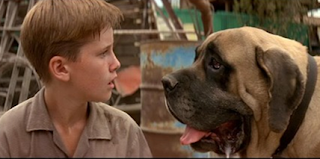The Sandlot - Implicit
Messages

The Sandlot
is a coming of age movie centered on one of America’s greatest institutions,
baseball. Its target audience is preteen through mid-teen boys. This
lighthearted comedy is about a rather shy fifth grader, Scotty Smalls, who
finds himself in a new town just before the end of school. Being a baseball
neophyte, both in his knowledge and skill, he is befriended by Bennie
Rodriquez, the best baseball talent in the community, who teaches him to play
the game. Through this friendship, Scotty becomes part of a ragtag team of boys
who are also social comrades through thick and thin. Through the summer, they
share many adventures including a major “pickle” as it was described. One day
when the boys have damaged their only baseball, Scotty comes to the rescue by
taking his stepdad’s prized Babe Ruth autographed ball as a replacement. When
Scotty launches a homer over the fence, the baseball lands in the
neighborhood’s scariest yard, protected by a monster junkyard dog known as “The
Beast” who, by legend, has eaten trespassers and is owned by the meanest man in
town. Facing sure “death” if not returned to Scotty’s stepfather’s trophy room,
their only option is to retrieve the ball. This leads to their hilarious quest
to make this happen. According to Giannetti’s thesis discussed in Understanding Movies, this movie, set in
the 1960s, takes a rightward leaning slant which can be demonstrated in a
number of ways. One marker of this is that boys are “disciplined, respectful,
and obedient to their elders” (Understanding Movies). The movie pays homage to
the legends of the game like Babe Ruth and honors adherence to the rules of the
game. While the overt theme of the movie is that baseball is the greatest
single passion a young boy can possess, there are also underlying implicit
messages, both positive and negative, that can be identified. On the positive
side, there are messages about comradery, social interactions, problem solving,
overcoming fears and dispelling stereotypes. From a negative perspective, women
and girls are objectified, portrayed as subservient to men, and cast in a
negative light. There is also a distant coldness that can be observed in a
stepparent’s interaction with a stepchild and devaluation of that child’s
worth. Undercurrents of a lack of investment in the overall relationship can
also be identified. For this review, a closer analysis of just one positive and
one negative message will be addressed. In the movie The Sandlot, in keeping with the humorous and lighthearted tone of
the film, the positive message of problem solving is by far the more dominant
message in comparison to the negatively framed awkward relationship between a
stepfather and a stepson.

One
of the most positive implicit messages that is championed in this film is that
of problem solving. The prime example of this is the progression of methods
employed by the boys to accomplish their goal to reclaim the baseball. First
off, they tried a wooden broom handle to pull the ball back towards the fence.
This failed when “The Beast “stomped on the ball with his foot and shredded the
handle with his teeth. Not discouraged, the boys attached a metal pan to a
sturdy metal pole, passed it through the fence and trapped the ball. As they
were pulling it back towards them “The Beast” again foiled the plan, crushing
the pole and throwing the mangled mess across the baseball diamond. Undaunted, they
upped their game and fastened a catcher’s mask to the suction end of three
vacuum hoses. Centering the mask over the ball, the vacuums were turned on
securing the baseball. As it was being lifted over the fence, “The Beast”
attacked, knocking it loose. He damaged the hose ends causing each vacuum to
blow up. Not phased, the boys came up with an even more ingenious plan. Wearing
the catcher’s chest protector with ropes tied to it, threaded through pulleys,
one of the boys was lowered into the yard very stealthily, so as to not disturb
“The Beast”. All was going well until
they came face to face. Jerking the boy to safety, the ball was jarred loose,
ending that plan. Pulling out all the stops, Scotty constructed a sophisticated
robot catapult. Rolling it down a track into the yard, the catapult was
positioned and cleanly thrust the ball into the air. At the last possible
second, “The Beast” leaped high into the air and caught the baseball in his
mouth. Finally, after much soul searching and preparation, Bennie jumped into
the yard, grabbed the ball and alluded “The Beast” during a lengthy chase.
Mission accomplished, the elusive ball was back in their passion.
The
positive message of problem solving is by far the most dominant. I have
highlighted just one example, but there are many others woven throughout the
film. This is a life skill that successful leaders must possess, according to
analysis done by Jack Zenger and Joseph Folkman published in the Harvard
Business Review. Creativity, hard work and perseverance are all components of
problem solving that were demonstrated in the movie. This message was
effectively delivered and generates an all things are possible message. Even
when faced with adversity, there is always a solution to be found.

In
selecting a negative implicit message that can be found in The Sandlot, the stepfather and stepson relationship between Scotty
and Bill is the best example. Scotty’s mother and Bill have been married for a
year, yet Scotty and Bill’s relationship is distant. Every time Scotty
addresses Bill, he stutters and stammers. Bill either ignores him or gives
Scotty a curt response. In their new house, Bill has a trophy room, and it is
strictly off limits to Scotty. Having
just met the sandlot boys, Scotty wants Bill to show him how to catch and
throw, but his meek requests go unfulfilled. Not until his mother steps in, is
Bill willing to give him a lesson. That doesn’t go well at all because Scotty
is terrible at baseball. The audience can see Bill roll his eyes, sigh and show
annoyance at Scotty’s ineptitude. Interestingly enough, as Scotty hones his
baseball skills through practice with the sandlot gang, his newly acquired
ability makes Scotty attractive to his stepdad who then accepts him because he
has become a “jock”.
The
implicit negative stepfather stepson relationship is well delivered, much in
part to the performance of actor Denis Leary whose bread and butter has been to
play intolerant, flippant sarcastic roles. As a stepdad, he delivers a
believable performance as a self-centered, self-consumed king of his castle
character. The reason that this relationship is not the dominant implicit
message is that the audience sees it as a work in progress. This is reinforced
by the bonding between the two as Scotty demonstrates his new found athletic
prowess. Interestingly, what was once a negative implicit message at the
beginning of the movie, actually turns into a problem solving success for
Scotty. His hard work to become good at baseball provides an area of interest
and commonality between the two of them.

The
Sandlot is a humorous
movie about the escapades of a group of preteens and their love of baseball.
Upon close analysis, implicit messages can be identified. Of these, the
positive message of problem solving is the most dominant, as it is woven
throughout the film. With its real life implications for success, if mastered,
this is a valuable message for young people to be exposed to. The Sandlot does this well. Of less
emphasis and importance to the film, a negative implicit message concerning
stepfather and stepson relationships can be observed. In its delivery and
coverage of these implicit messages, this film hits a grand slam and is most deserving
of a five star rating.
 Friendship and courage are also
strong themes in this movie. Friendship is shown through all of the
relationships between the bugs in the film. You will find that the bugs are
often times very supportive of each other, even when they find themselves in
hard situations or if they are at fault for something. Courage in this movie is
often seen through the main character Flik. Flik is often times found in rough
situations ruining things for the colony as a whole but in the end he is proud
of all of his hard work, and comes out of his shell to ultimately face what
everyone has been afraid of.
Friendship and courage are also
strong themes in this movie. Friendship is shown through all of the
relationships between the bugs in the film. You will find that the bugs are
often times very supportive of each other, even when they find themselves in
hard situations or if they are at fault for something. Courage in this movie is
often seen through the main character Flik. Flik is often times found in rough
situations ruining things for the colony as a whole but in the end he is proud
of all of his hard work, and comes out of his shell to ultimately face what
everyone has been afraid of. 






















